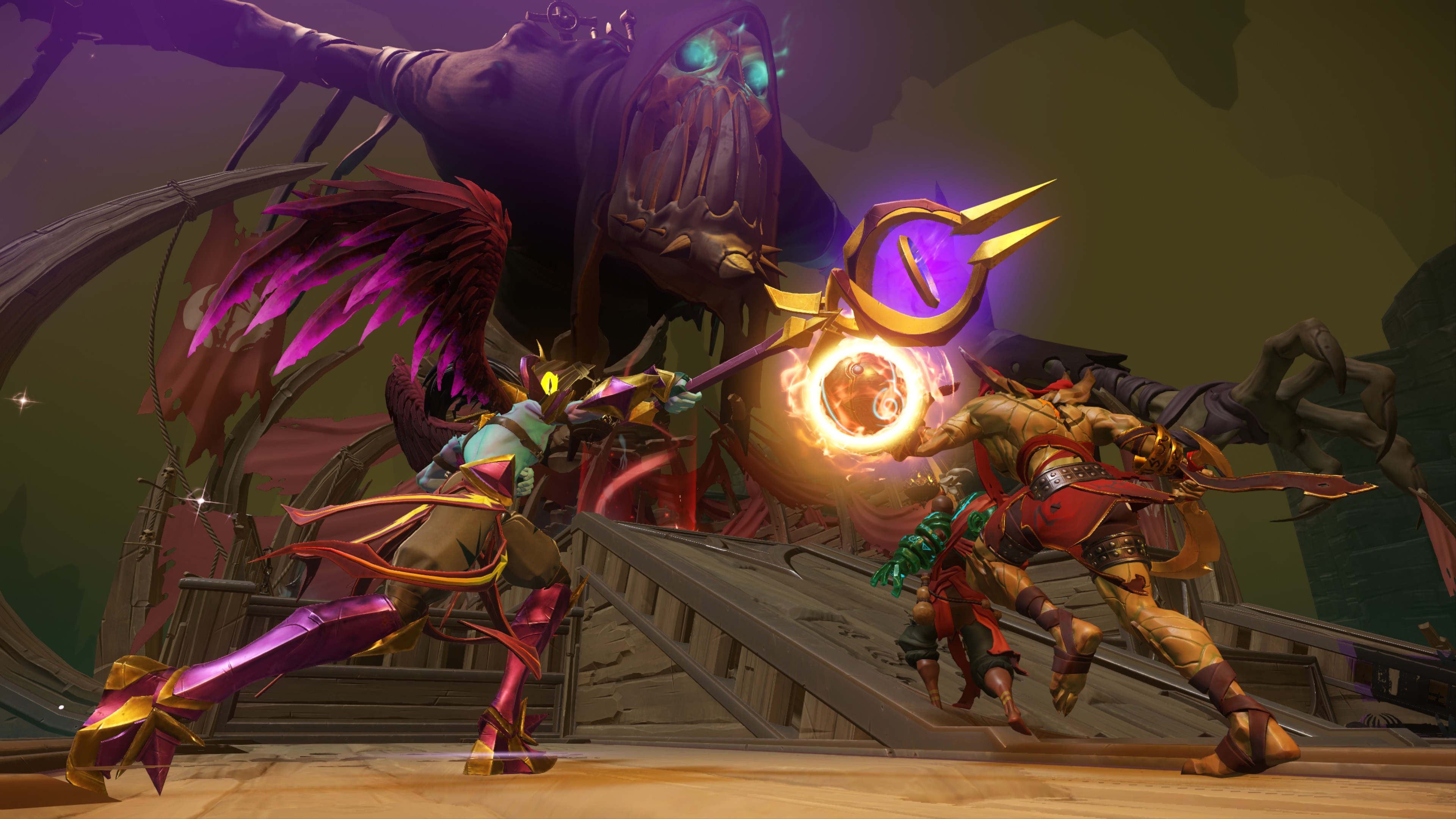Amazon’s fantasy sports game Breakaway shoots, but may not score
Breakaway runs well in alpha, but it has no idea what kind of game it wants to be.

Breakaway takes a tired formula and injects the tiniest amount of personality into it. It’s not hard to understand why Amazon’s 2014 acquisition, Double Helix, was put to work on Breakaway, especially given its track record of refining existing formulae with a combination of skill and charm. The studio's prior work with Killer Instinct brought something to the fighting game space that was sorely lacking. But Breakaway feels hollowed out—almost like there’s a corporate joystick driving the project, instead of capitalizing on Double Helix’s cheeky ideas.
Breakaway is a 4v4 fantasy sports game. The goal is to pick up a ball-shaped 'relic' and score points for your team, driving down one of a number of differently configured arenas by utilizing your hero’s abilities. There are distinct lanes to push, but it isn’t a traditional MOBA or hero brawler like you’d expect from League of Legends or Heroes of the Storm. “You can see that in the core gameplay, the focus on a ball, and the two competing teams,” executive producer, Matthew Priestley, told me over email. “Ball passing, situational awareness and team fighting matter as much or more than individual skill.”

There are 10 characters to play as in Breakaway’s alpha. Each of the characters has a different set of abilities to complement the team’s composition, much like you’d expect from a multiplayer action game. The 10 characters are different enough from one another, especially cosmetically, that choosing one to suit my play style at the moment wasn’t much of a stretch. Unfortunately, the gameplay felt too homogenous between matches for me to get much of an impression of either Alona or Thorgrim, my chosen characters.
As you play Breakaway, you gain gold to upgrade your character’s four different traits during the match: speed, damage reduction, attack damage increase, and more. You can improve those traits up to four times, so even though you’re stuck with the four traits per match, it’s easy to make them work for your character. I favored speed upgrades in both of my matches, as it made all the difference in pushing the relic up the playfield.
Breakaway's tempo is one of its best assets. “The rounds [in Breakaway] never last more than four minutes and the action never really lets up,” Priestley said over email. “You can easily get in a full match of Breakaway in fifteen minutes.” It’s a quick competitive hit in a space where a round of League of Legends can run you 45 minutes, and Heroes of the Storm is usually at least 20.
At the same time, Breakaway isn’t sure what it’s trying to be. It’s touted as a fantasy sports game, but it plays like a brawler with deeply unsatisfying combat. Buildables, which are unique to each character (like Alona’s area-of-effect healing totem or Thorgrim’s wall) can be built once per round and felt useful. If your team managed to keep those buildables up during the round, they stack—so, if you’re smart, you can have a number of the same buildables scattered throughout the playfield. But other than those first moments when I dropped them on the field, I felt like I was waffling around the arena, spamming heal (while I was playing as Alona), and hoping for the best. Even when playing as Thorgrim, a tank with shields and a frosty warhammer, it didn’t feel like I was all that effective.
There’s nothing wrong with a steep learning curve, especially in competitive games, but when players are unsure and tentative, it’s often an all-or-nothing experience. I need to put more time into Breakaway, but in the matches I played felt uneven, and the result felt determined long before the match point. But it isn’t necessarily the learning curve—it’s the jumbled mess of a playfield with too many players vying to occupy the same spaces.
Keep up to date with the most important stories and the best deals, as picked by the PC Gamer team.

Breakaway can’t settle on what it’s trying to be, and the gameplay suffers for it.
Priestley insisted that because Breakaway is “a sport with a tight play field, [it] can be super intense.” To me, Breakaway is a staid experience, teetering on boring. There wasn’t anything intense about the matches I played. The game’s alpha is a lacklustre attempt at the excitement of competition without the satisfying thrill of victory (even when we won). In its current iteration, Breakaway focuses too much on making the gameplay fun to watch (especially with its focus on Twitch integration) rather than making it fun to play.
It isn’t all bad, mind you. For an alpha, Breakaway is smooth and effortless to play. There were no visible stutters with the controls or animation. The framerate is consistent, which highlights Double Helix’s fighting game roots. “Our abilities, animations, and FX are all tightly timed to communicate precisely when and where damage will occur,” Priestley said.
Breakaway is swinging for the fences, but can’t seem to connect with the concepts it’s attempting to communicate to players. The sports mechanics are well-implemented, passing in particular, but unimaginative in spite of its fantasy backdrop. Combat is precise, but it’s deeply unsatisfying. It’ll be interesting to see how the game evolves from alpha to beta, especially given that no release date has been set. In the meantime, Double Helix has a lot of work to do before Breakaway will be ready to hit that homer.

